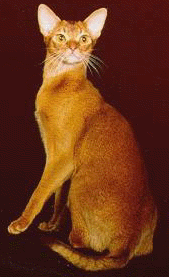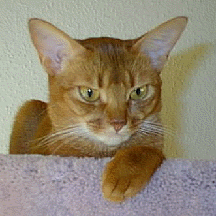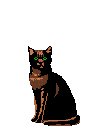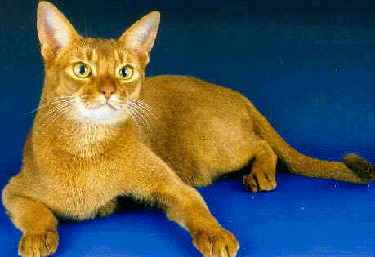|
CONTENTS OF THIS WEB PAGE:
Click these links to
Discover the Abyssinian's:

Abyssinians -
Origins and Appearance


Although the origins of the most recent predecessors of the Abyssinian breed of cats has been traced fairly conclusively to parts of India, Singapore, and Ceylon, there is a remarkable resemblance between this modern breed and the cats held sacred in Ancient Egypt. This has been determined by comparing the appearance of modern Abyssinains with the paintings, statues, carvings and mummies of cats found in abundance in Egyptian tombs and temples, and also carved on various ancient public monuments.
Although the ancient representations of Cats in Egypt also closely resemble the African Wild Cat in color and markings, the Abyssinian is still considered by many to be the most likely candidate to be direct descendents of the “sons and daughters” of the Egyptian Cat goddess Bast or Bastet. The temple to the mother goddess Bast was purportedly filled with the cats Egyptians held as sacred to and representative of her. Bast, like her feline counterparts, was seen as a protecting deity. Just as cats ferret out and destroy the pesky rodents in a home that cause damage, filth and disease, so too Bast was seen as a protector of women and children as well as the Pharaoh, and also as destroyer of their enemies and their avenger.
Abyssinians are of medium size, and are lithe, agile and very regal in bearing. Their muscular bodies are covered with a sleek, short, flecked coat. It is this agouti (bristled) style ticking or flecking in their coats which gives Abyssinians a “wild look.” As they lope across a room, one is reminded of a Wild Cat on the hunt, fleet of foot and confident in its own abilities to defend and care for itself.


Abyssinian Cat with a Cinnamon Coat


Temperament and Characteristics


Abyssinians are extremely sociable, affectionate and intelligent cats. They like to be involved in their surroundings, and although they are not necessarily lap cats, they do love company and attention.
Unlike most other cats, an Abyssinian’s highly social antics and sharp intelligence make it a poor choice of pet for those who prefer the more aloof independence and self-sufficiency displayed by other types of cats. Abyssinians are ideally suited to be pets in a lively family situation. These cats love to interact with others and can be easily trained to fetch small objects and do various tricks.
Since Abyssinians are highly social, they do not do well if left alone for long periods of time. Therefore, if this is going to be the case, it is recommended that a person should own two Abyssinians to keep each other company when their owner is away.
Abyssinians are well-suited to remaining indoors and they make ideal house cats as long as they have ample room and opportunity to romp, scratch and play. They also get along well with dogs and can hold their own against them if any hostility initially exists between them. In fact, Abyssinians have many dog-like qualities which makes them a good choice of cat for people who enjoy the social interaction, ability to easily learn and perform tricks, and playful antics dogs are ordinarily known for. Abyssinians are also excellent mousers.
Abyssinians are not vocal and when they do meow, it is a delightful sound, having a soft, bell-like quality to it. Overall, Abyssinians make wonderful, generally healthy and vigorous pets and companions. It is no small wonder why the Ancient Egyptians loved these cats so much that they eventually deified them and made them sacred.
All in all, Abyssinian cats are a wonderful feline variety of pet. In addition to making excellent companions, some say that the Abyssinian has a rightful claim to being the oldest domesticated cat breed known to humanity. They may also be the closest to being a true natural breed of cat from which all other cat varieties can be derived through selective breeding.
Can you hear all of my feline friends on this page purring to you? They are purring because they are grateful you have come to learn more about them. Please come again and visit them sometime. I am sure they will be glad to see you! Now, read on to learn about the overall appearance and delightful color varieties that Abyssinians come in…



A Litter of Abyssinian Kittens,
the one to the left with a Chocolate Coat
and the one in the front with a Silver colored coat

Color Varieties


The many illustrations here of modern Abyssinian cats give a good overall picture of what the finest pedigree cats of this type look like. They come in a wide variety of tonal variations.
GENERAL APPEARANCE: Abyssinain cats are of medium build with long tails, slender, well-formed legs, and lithe, graceful, muscular bodies. In profile, an Abyssinian’s head shows a gentle rounding to the brow with a slight nose break leading to a firm chin. Their ears are set well apart and are pricked, well-cupped, large, broad at the base and preferably tufted. Their large, bright, and expressive eyes are almond shaped and set well apart. Their eye color can be green, gold or hazel with a rich depth of color. Their coats are short and fine with a lustrous sheen, but long enough to accommodate two or three bands of ticking in the fur.
Here are the twelve recognized color types or standards that Abyssinians are known to come in:
BLUE: Coat is soft blue ticked with slate blue and an oatmeal undercoat. Tail is tipped with slate blue.
BLUE SILVER: Coat is clear silver ticked with blue with a silvery white undercoat. Any spinal shading to be blue.
CHOCOLATE: Coat is rich chocolate, ticked with deeper shades of chocolate brown. Undercoat is paler brown and spinal shading is darker than overall coat.
CINNAMON: Coat is a glowing, rich cinnamon red, ticked with chocolate brown and with a deep apricot undercoat. Spinal shading should be darker than overall coat.
CINAMMON SILVER: Coat is clear silver ticked with cinnamon red. Hair tips darkest with a silvery white undercoat. Spinal shading is cinnamon.
CREAM: Deep cream coat, ticked with deeper shades of the same toning. Hair tips darkest with a light cream undercoat. Any spinal shading to be of a deeper color.
FAWN: Coat is a warm rose-beige, ticked with a light cocoa brown. Hair tips are darkest with an oatmeal undercoat. Any spinal shading to be of a deeper color.
LILAC: Coat is a dusty lilac, ticked with deeper shades of the same toning. Hair tips to be darkest with a pale oatmeal undercoat. Any spinal shading to be of a deeper color.
SEX-LINKED RED: Bright apricot coat, ticked with deeper shades of the same tone. Hair tips darkest with a soft apricot undercoat. Richer colors most sought after. Any spinal shading to be of a deeper color.
SILVER: Coat is clear silver ticked with black. Hair tips darkest with silvery white undercoat. Any spinal shading to be black.
TAWNY: Coat is a glowing rich orange brown, ticked with black. Hair tips darkest with a deep apricot undercoat. Any spinal shading to be of a deeper color.
TAWNY TORTOISESHELL: Coat is a glowing rich orange brown, ticked with black and with gold patches or brindling (streaking or spotting). Hair tips darkest with a deep apricot undercoat. Any spinal shading to be of a deeper color.


An Abyssinian Cat with a Tawny Tortoiseshell Coat



Abyssinians and their
Relationship to Mau Cats


One final note. Though Abyssinians (and their close cousins, the Singaporean breed of cats) closely resemble the cats found mummified in Egypt, there is another contender for the label of world’s oldest breed of domestic cat and a cat type that was also found in Ancient Egypt. That is the Egyptian Mau cat, thought to also be descended from the African Wild Cat and with similar personality traits in common with both the African Wild Cat and Abyssinians. The Mau comes in several colors but is most often found as a white or whitish cat with black spots or stripes, large almond shaped green eyes and a surprised or frightened appearance on its face.
Personally, I favor the look of the Abyssinian over the Mau, but as with all personal choices, in Ancient Egypt some may have preferred the cat that looked like the Abyssinian, especially in the Old and Middle Kingdoms, whereas the Mau type cats gained favor much later in Egypt’s history. Cats like the Mau with their whiter coats and spots or stripes can be seen in some New Kingdom art. Which breed or type of cat was more favored in Ancient Egypt is, of course, a matter of opinion. To help you form your own, I have included a link to Emau Cattery and the CFA Mau cat web page below.
CLICK ON THE MAU BELOW
To learn more about Maus!
Photo below:
Emau Cattery’s Mau cat “Comet”
Cat Fancier’s Association MAU FACTS

If you are interested in purchasing
Abyssinian cats
or learning more about them,
check out the following links:

Thank you for visiting!
| 











 To Seshat’s Per at Pan Historia
To Seshat’s Per at Pan Historia 
